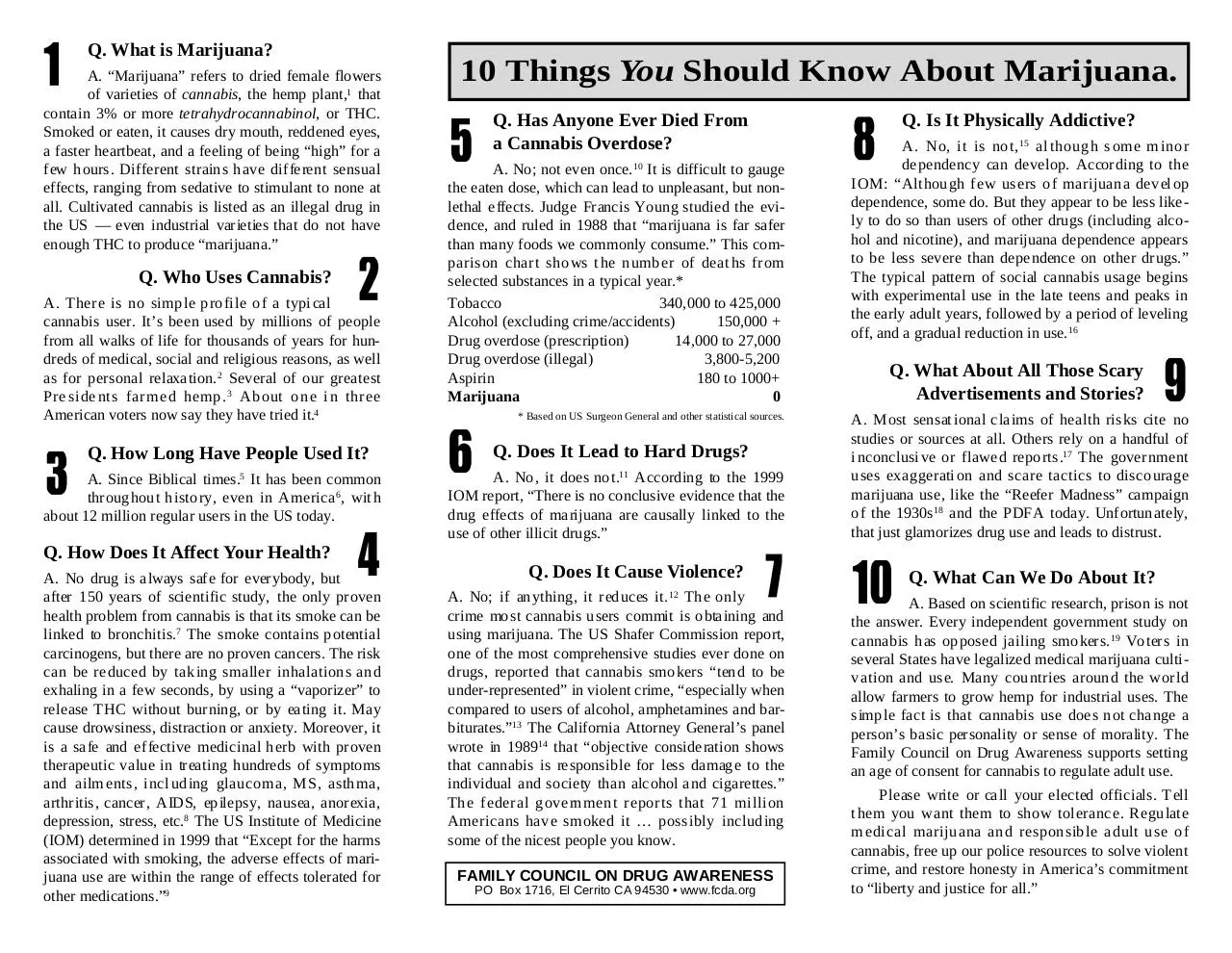TenThings.00 (PDF)
File information
Title: ffcc.survey
Author: Chris Conrad
This PDF 1.2 document has been generated by QuarkXPressâ„¢ 4.0 / [ClibPDF Library 2.02-r1-1] PrintToPDF 2.4, and has been sent on pdf-archive.com on 25/03/2016 at 05:54, from IP address 104.207.x.x.
The current document download page has been viewed 381 times.
File size: 24.25 KB (2 pages).
Privacy: public file


File preview
“Penalties against
possession of a drug should
not be more damaging to
an individual than the use
of the drug itself.”
— President Jimmy Carter
Message to Congress. August 2, 1977
Distributed locally by:
— Please photocopy and share this information —
Read Hemp, Lifeline to the Future, by Chris Conrad.
Request your free copy with any $20 donation to:
FCDA. PO Box 1716, El Cerrito CA 94530. www.fcda.org
Footnotes to the text:
1. Researchers count about 50,000 industrial uses for cannabis hemp; in
food, clothing, housing, paper, textiles, fuels, plastics, medicine, sealants,
and more. Sources: Encyclopaedia Brittanica, US Dept. of Agriculture;
Conrad, Chris. Hemp: Lifeline to the Future, 1993, 1994.
2. In The Bible, God told people to use all the seed bearing herbs, which
describes the cannabis plant. Genesis 1:12, 29-31, 2:15. Coptic Christians,
Rastafarians, Hindus, Sufis, Buddhists, Zoroastrians, and other churches
consider the plant to have sacramental value.
3. Thomas Jefferson, George Washington, who wrote about tending to his
female plants and a “curious” preparation of hemp (1794), and others.
President Bill Clinton smoked marijuana in college in the 1970s.
4. National Institute of Medicine (IOM). Marijuana and Medicine: Assessing the Science Base. National Academy Press. Washington DC, 1999.
5. Archeologists report that cannabis was one of the first plants cultivated
by humans — about 8000 BC. Columbia University History of the World,
1972. Its fiber was used for rope, paper, sails and garments. It was used as
medicine in China by 2700 BC. US Dept. of Agriculture Yearbook, 1913.
It was smoked in India by 1400 BC. Atharvaveda.
6. A tradition in the Middle and Far East, Turkish smoking parlors were
featured at the 1876 US Centennial Expo in Philadelphia. An exhaustive
two-year study of “gunjah” smokers in India, the British “Raj” Indian
Hemp Drugs Commission, 1896, found no “physical, mental, or moral”
reason to ban or restrict cannabis use.
7. “The only clinically significant medical problem that is scientifically
linked to marijuana is bronchitis. Like smoking tobacco, the treatment is
the same: stop smoking.” Dr. Fred Oerther, MD, 1991.
8. Conrad, Chris. Hemp for Health, 1997. Grinspoon, Dr. Lester. Marijuana: The Forbidden Medicine, 1993. Mikuriya, Dr. Tod. Marijuana:
Medical Papers, 1839-1972, 1972.
9. National Institute of Medicine, IOM. Op. cit. 1999.
10. Young, Judge Francis ACT et. al. vs DEA; Docket # 88-22. 1988.
11. Costa Rican Study, 1980. Jamaican Study, 1975. US Shafer Commission, The President’s Commission on Marijuana & Other Drugs, 1972.
12. This has been reported in virtually every study ever done on cannabis.
Furthermore, the “Siler Commission,” 1931, studied US troops in Panama
and found “no impairment” in personnel who smoked cannabis off-duty.
The FBI reports that 65-75% of violent crime is alcohol related.
13. Shafer, Op. cit. Marijuana: A Signal of Misunderstanding . 1972.
14. California Attorney General’s Research Advisory Panel 20th Annual
Report, 1989 (released 1990; portions suppressed).
15. IOM, Op. cit. 1999. Mikuriya, Op. cit. 1972. Young, Op. cit. 1988.
LaGuardia Comsn., NY Mayor’s Report. 1944. See footnote 19.
16. Kaplan, John; Marijuana: The New Prohibition, 1970. Shafer, Op. cit.
1972. NIDA National Household Surveys, 1970-1999.
17. Old reports “purporting to show structural damage in the brains of
heavy marijuana users [has] not been replicated with more sophisticated
techniques.” In fact, new research indicates that cannabis may be neuroprotective and can prevent brain cells from damage caused by strokes or
head trauma. IOM, Op. cit.1999.
18. Federal bureaucrat Harry Anslinger’s campaign of bigotry against
cannabis use. His lies were eventually exposed, (Sloman, L. Reefer
Madness.) but not before marijuana prohibition was enacted in 1937. The
ban was written in secret and passed over the objections of the American
Medical Association and hemp businesses. Conrad, Op. cit. 1994.
19. Among them: Indian Hemp Drugs Commission (British, 1896); Siler
Commission (US Army, 1933); LaGuardia Commission (NY, 1944);
Shafer Commission (US, 1972); LeDaine Commission (Canada, 1972);
Alaska State Comsns. (1989, 1990); California Attorney General’s Research Advisory Panel (1990), etc.
Responsible decisions based on
accurate information.
Brochures: 10/$2.50; 100/$15.00; 1000/$100.00
Item# FCDA TT-0011.
Additional copies available from:
Family Council on Drug Awareness
PO Box 1716, El Cerrito CA 94530 • www.fcda.org
10
THINGS
EVERY
PARENT,
TEENAGER &
TEACHER
SHOULD
KNOW
ABOUT
MARIJUANA
Produced as a public service by the
Family Council on Drug Awareness
Updated for
a New Millennium!
Q. What is Marijuana?
A. “Marijuana” refers to dried female flowers
of varieties of cannabis, the hemp plant,1 that
contain 3% or more tetrahydrocannabinol, or THC.
Smoked or eaten, it causes dry mouth, reddened eyes,
a faster heartbeat, and a feeling of being “high” for a
few hours . Different strains have different sensual
effects, ranging from sedative to stimulant to none at
all. Cultivated cannabis is listed as an illegal drug in
the US — even industrial varieties that do not have
enough THC to produce “marijuana.”
Q. Who Uses Cannabis?
A. There is no simple profi le of a typi cal
cannabis user. It’s been used by millions of people
from all walks of life for thousands of years for hundreds of medical, social and religious reasons, as well
as for personal relaxation. 2 Several of our greatest
Pre si de nt s farm ed hemp. 3 About one i n three
American voters now say they have tried it.4
Q. How Long Have People Used It?
A. Since Biblical times.5 It has been common
throughout history, even in America 6, wit h
about 12 million regular users in the US today.
10 Things You Should Know About Marijuana.
Q. Has Anyone Ever Died From
a Cannabis Overdose?
A. No; not even once. 10 It is difficult to gauge
the eaten dose, which can lead to unpleasant, but nonlethal effects. Judge Francis Young studied the evidence, and ruled in 1988 that “marijuana is far safer
than many foods we commonly consume.” This comparis on chart shows t he number of deat hs from
selected substances in a typical year.*
Tobacco
340,000 to 425,000
Alcohol (excluding crime/accidents)
150,000 +
Drug overdose (prescription)
14,000 to 27,000
Drug overdose (illegal)
3,800-5,200
Aspirin
180 to 1000+
Marijuana
0
* Based on US Surgeon General and other statistical sources.
Q. Does It Lead to Hard Drugs?
A. No, it does not.11 According to the 1999
IOM report, “There is no conclusive evidence that the
drug effects of marijuana are causally linked to the
use of other illicit drugs.”
Q. Is It Physically Addictive?
A. No, i t is not, 1 5 al though s om e m inor
dependency can develop. According to the
IOM: “Alt hough few us ers of marijuana devel op
dependence, some do. But they appear to be less likely to do so than users of other drugs (including alcohol and nicotine), and marijuana dependence appears
to be less severe than dependence on other drugs.”
The typical pattern of social cannabis usage begins
with experimental use in the late teens and peaks in
the early adult years, followed by a period of leveling
off, and a gradual reduction in use. 16
Q. What About All Those Scary
Advertisements and Stories?
A. M ost sensat ional claims of health ris ks cite no
studies or sources at all. Others rely on a handful of
i nconclusi ve or flawed reports .17 The government
uses exaggerati on and scare tactics to discourage
marijuana use, like the “Reefer Madness” campaign
of the 1930s18 and the PDFA today. Unfortunately,
that just glamorizes drug use and leads to distrust.
Q. How Does It Affect Your Health?
A. No drug is always safe for everybody, but
after 150 years of scientific study, the only proven
health problem from cannabis is that its smoke can be
linked to bronchitis.7 The smoke contains potential
carcinogens, but there are no proven cancers. The risk
can be reduced by taking smaller inhalations and
exhaling in a few seconds, by using a “vaporizer” to
release THC without burning, or by eating it. May
cause drowsiness, distraction or anxiety. Moreover, it
is a safe and effective medicinal herb with proven
therapeutic value in treating hundreds of symptoms
and ailm ents , i ncl uding glaucom a, M S, asthma,
arthritis , cancer, AIDS, epilepsy, nausea, anorexia,
depression, stress, etc.8 The US Institute of Medicine
(IOM) determined in 1999 that “Except for the harms
associated with smoking, the adverse effects of marijuana use are within the range of effects tolerated for
other medications.”9
Q. Does It Cause Violence?
A. No; if anything, it reduces it. 12 The only
crime most cannabis users commit is obtaining and
using marijuana. The US Shafer Commission report,
one of the most comprehensive studies ever done on
drugs, reported that cannabis smokers “tend to be
under-represented” in violent crime, “especially when
compared to users of alcohol, amphetamines and barbiturates.”13 The California Attorney General’s panel
wrote in 198914 that “objective consideration shows
that cannabis is responsible for less damage to the
individual and society than alcohol and cigarettes.”
The federal government reports t hat 71 mi lli on
Americans have sm oked it … poss ibly including
some of the nicest people you know.
FAMILY COUNCIL ON DRUG AWARENESS
PO Box 1716, El Cerrito CA 94530 • www.fcda.org
Q. What Can We Do About It?
A. Based on scientific research, prison is not
the answer. Every independent government study on
cannabis has opposed jailing smokers. 19 Voters in
several States have legalized medical marijuana cultivation and us e. Many countries around the world
allow farmers to grow hemp for industrial uses. The
s imple fact is that cannabis use does not change a
person’s basic personality or sense of morality. The
Family Council on Drug Awareness supports setting
an age of consent for cannabis to regulate adult use.
Please write or call your elected officials. Tell
t hem you want them to show tol erance. Regulat e
m edi cal marijuana and responsible adult use of
cannabis, free up our police resources to solve violent
crime, and restore honesty in America’s commitment
to “liberty and justice for all.”
Download TenThings.00
TenThings.00.pdf (PDF, 24.25 KB)
Download PDF
Share this file on social networks
Link to this page
Permanent link
Use the permanent link to the download page to share your document on Facebook, Twitter, LinkedIn, or directly with a contact by e-Mail, Messenger, Whatsapp, Line..
Short link
Use the short link to share your document on Twitter or by text message (SMS)
HTML Code
Copy the following HTML code to share your document on a Website or Blog
QR Code to this page

This file has been shared publicly by a user of PDF Archive.
Document ID: 0000353221.